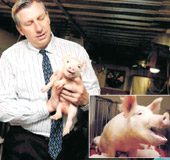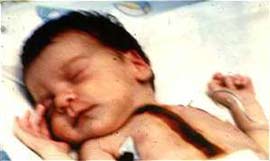The interspecies organ transplantation project is nearing implementation as the world’s first genetically modified pigs hold promise for new therapies to treat various diseases. Scientists have made initial successes in transplanting their organs into baboons, and human trials may begin within a few years…
 |
David Ayares with a million-dollar pig (large image) and the genetically modified pig herd (Photo: NLĐ) |
At the Revivicor farm on Blue Ridge Hill, the genetically modified pigs with erect ears are growing rapidly. “These are million-dollar pigs,” says David Ayares, the farm owner and CEO of Revivicor Biotechnology, “Their DNA has been modified to lack the alpha-1-galactose sugar, which causes the human body to reject their tissues and organs…” He further explains: “Our bodies carry specific antibodies that quickly recognize this sugar and will trigger a rejection response within minutes. Therefore, this gene has been modified, and there will be further modifications to other sugar-producing genes in the next pig herd… One day soon, their organs will be safe for transplantation into humans…”
Positive Signals
Recognizing the potential of interspecies organ transplantation as a breakthrough in biological science, the University of Pittsburgh Medical Center (UPMC), through its joint venture with Revivicor, has boldly invested in this controversial field. “Interspecies organ transplantation is a promising area that humanity can explore,” states Professor Thomas E. Starzi, an experienced transplant expert at UPMC. He is one of the pioneers seeking alternatives to address the severe shortage of available organs. “UPMC and Revivicor are achieving initial successes, promising feasible plans for the future…” he adds.
 |
| In the future, pig organs will be safely transplanted into humans (Photo: NLĐ) |
In experiments at UPMC, genetically modified pig hearts have shown promising progress approximately three months after being transplanted into baboons, with some exhibiting a longer “lifespan”… This success is expected to extend even longer, potentially reaching six months or more as scientists make additional adjustments to the pig genome.
A $6 Billion Market
Since 2004, kidney transplantation experiments from pigs into monkeys at UPMC, led by Dr. Massimo Trucco, have also seen certain successes. Researchers here are planning to transplant pig hearts into patients suffering from severe heart failure as replacements for mechanical pumps. According to estimates by Revivicor, the future market for pig organ transplants is projected to be worth at least $6 billion. UPMC, Revivicor, and the U.S. Food and Drug Administration (FDA) plan to conduct human clinical trials within the next few years… The primary goal is to use specialized insulin-producing cells from pig kidneys to improve insulin levels in Type 1 diabetes patients; around 40 patients at the Children’s Hospital in Mexico have received pig kidney cell transplants over the past five years, with some experiencing a significant reduction in insulin supplementation needs…
According to a survey by the U.S. Department of Health, there are currently over 90,000 people waiting for organ transplants across the country, and it is estimated that around 6,300 people died in 2005 while waiting for transplants. Experts estimate that only about half of the donated organs come with the consent of the donor, especially kidneys and hearts…
From Monkeys to Pigs
UPMC’s interest in interspecies organ transplantation is not a new concept. In 1992, under the guidance of Professor Starzi and Dr. John J. Fung, surgeons at the University of Pittsburgh transplanted a baboon liver into a 35-year-old male patient. The patient survived for 70 days. Another baboon-to-human liver transplant was conducted in 1993, but the recipient died after 26 days due to infection…
 |
| Baby Fae’s chest received a baboon heart in 1984 (Photo: BBC) |
The effort for interspecies organ transplantation began with the world-famous case of Baby Fae. On October 26, 1984, doctors at the Loma Linda University Medical Center in California implanted the heart of a baboon into this baby girl. After a few days of good health with a functioning heart, her body began to mount an acute rejection response, and she died 20 days after the heart transplant… “There is a lot of promise for interspecies organ transplantation in the future; however, this field cannot bring success overnight as we desire,” says Dr. Christopher McGregor, a transplant expert at the Mayo Clinic.
With this ambition, there are currently at least eight companies pursuing research projects on interspecies organ transplantation. Pig organs have emerged as a promising direction because their organ sizes are very compatible with human bodies, and pigs are less controversial than primates, as they are commonly raised for meat…
Anti-Clotting Gene
In a report published in the November issue of the journal Transplantation last year, Cooper noted that six out of eight baboons that received genetically modified pig hearts survived nearly six months. However, they struggled with immune rejection reactions, primarily due to clotting conditions in small blood vessels. These clots grew larger and ultimately led to the death of the experimental animals.
Currently, scientists at the University of Pittsburgh have incorporated a human-derived anti-clotting gene into pigs to help address this issue. Researchers at Imperial College London have also succeeded in experiments demonstrating this capability in rodents. “This anti-clotting gene helps prevent all common rejection responses encountered during organ transplantation,” Cooper stated. Revivicor is currently working with the FDA to ensure that there are no 100 specific viruses and bacteria present in their pig herd that could pose risks to recipients…
A New Horizon
Researchers at UPMC have seen a promising horizon as the health insurer Highmark Inc. has underwritten $1.5 million as part of funding for new treatment methods, while Fujisawa Investments for Entrepreneurship L.P. has also invested $500,000… And, in September of last year, Revivicor signed a contract with Zimmer Holdings Inc., a company specializing in surgical products in Indiana, to use pig cells for transplantation, modifying damaged cartilage, ligaments, bones, and tissues. These grafts are extracted from pig skin, some used to treat hernias and common joint misalignments resulting from accidents. Experts say that when these cells die, their remnants can still be used to stimulate the growth of cells in and around the joints…
More Promising than Stem Cells According to Dr. David Kc. Cooper at the University of Pittsburgh—a transplant expert who has taught at Harvard University—organ transplantation between species is more feasible than stem cell approaches, and other scientists have indicated that it is entirely possible to replace any type of human cell using this “raw material.” “Creating a heart, a kidney, or a liver… from stem cells may still seem like a concept out of science fiction,” he says. That may only become a reality in… 50 or 100 years. However, with pigs, at least we already have available organs, especially as they have shown good functionality in animal experiments.” |
Dr. Cooper also stated that genetically modified pig hearts could provide temporary relief for patients suffering from congestive heart failure, a common condition in individuals whose hearts cannot pump enough blood to the organs in the body. Some patients with this condition are currently treated with mechanical solutions, specifically artificial pump devices implanted in the abdomen. According to Cooper, in certain special cases, the use of pig hearts may help patients survive longer than with artificial pump devices.
Gia Dao

















































